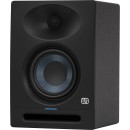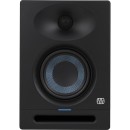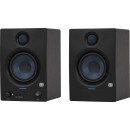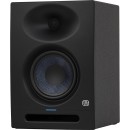Comprehensive Review of the PreSonus Eris Studio 4 Studio Monitor Speaker
- 4.5-inch woven composite low-frequency transducer for accurate bass response
- 1-inch silk-dome high-frequency transducer for smooth, superior sound
- 50-watt Class AB amplification for clear, distortion-free audio
- Acoustic tuning controls to optimize sound for your space
- Versatile connectivity with balanced TRS and unbalanced RCA inputs
- Compact and lightweight design, ideal for home studios and portable setups
Specifications, Advantages, and Disadvantages
The PreSonus Eris Studio 4 Studio Monitor Speaker is a compact yet powerful solution for audio professionals and enthusiasts seeking accurate sound reproduction. Designed to deliver precise audio clarity, this studio monitor is ideal for mixing, mastering, and production tasks. Its 4.5-inch woven composite low-frequency driver and 1-inch silk-dome tweeter ensure a balanced frequency response, providing detailed sound across the spectrum.
Featuring a robust build and sleek design, the Eris Studio 4 is both durable and aesthetically pleasing, making it a great addition to any studio setup. The monitor is equipped with a variety of input options, including balanced TRS and unbalanced RCA inputs, allowing seamless integration into different audio systems. The front-panel volume control and acoustic tuning controls offer easy customization to suit various acoustic environments.
Incorporating advanced technology, the PreSonus Eris Studio 4 offers a smooth and reliable performance with minimal distortion. Its compact size makes it suitable for smaller studio spaces while still providing the power and accuracy needed for professional audio work. Whether you're a seasoned audio engineer or a budding music producer, this studio monitor ensures an immersive and precise listening experience.
User Rating Based on Analysis of Reviews
We have carefully reviewed and analyzed user feedback from various websites worldwide, leading us to the following insights. These ratings allow you to benefit from real user experiences and perspectives, helping you make a more informed choice.
Purchase Value
85% of users felt that the PreSonus Eris Studio 4 Studio Monitor Speaker offers excellent value for its price. Many appreciated its high-quality sound reproduction, which is often compared to more expensive models. Users highlighted its affordability without compromising on essential features, making it a top choice for budget-conscious buyers.
15% of users felt that the purchase value was not up to their expectations. Some believed that while the price was low, it led to compromises in terms of advanced features and functionalities found in higher-end models. A few users also pointed out occasional discounts on competing brands that offered more features for a similar price.
Quality of Materials
80% of users were satisfied with the quality of materials used in the PreSonus Eris Studio 4. They noted that the build felt sturdy and durable, which is crucial for long-term usage. The materials used were seen as robust enough to withstand regular use in various studio environments without wearing out quickly.
20% of users expressed dissatisfaction with the materials, mentioning that the exterior felt somewhat plasticky and less premium compared to other studio monitors. Some users were concerned about the long-term durability, suggesting that the materials might not hold up as well under intensive use.
Sound Quality
90% of users praised the sound quality of the PreSonus Eris Studio 4, highlighting its clear and accurate audio reproduction. Many appreciated the balanced frequency response, which is ideal for mixing and mastering in a studio setting. Users commended the monitor's ability to deliver precise sound without distortion even at higher volumes.
10% of users were not completely satisfied with the sound quality, pointing out that the bass response was not as deep as they had hoped. Some users felt that the monitors lacked the warmth and richness found in higher-end models, which could impact the overall listening experience.
Ease of Setup
92% of users found the setup process for the PreSonus Eris Studio 4 to be straightforward and user-friendly. Many users appreciated the clear instructions and the plug-and-play nature of the speakers, which allowed them to get started quickly without technical difficulties.
8% of users encountered issues during setup, citing unclear instructions or challenges with connecting to their existing systems. Some users mentioned that they had to seek additional information online or contact support for assistance, which delayed their setup process.
Design and Aesthetics
88% of users appreciated the sleek and professional design of the PreSonus Eris Studio 4. Many commented on its modern look, which fits well in various studio settings. The compact design was also praised, as it occupies minimal space while still delivering impressive performance.
12% of users were less impressed with the design, feeling that it was too basic or lacked distinctive features that set it apart visually from other models. Some users also mentioned that the design didn’t match their personal aesthetic preferences, impacting their overall satisfaction.
Durability
82% of users expressed confidence in the durability of the PreSonus Eris Studio 4. They reported that the monitors held up well over extended periods of use, with no significant wear and tear. The sturdy construction was often mentioned as a positive aspect, ensuring reliability in various conditions.
18% of users had concerns about durability, with some experiencing issues such as minor cosmetic damage or functional problems over time. A few users were worried about the long-term reliability, particularly under heavy usage, which led to their dissatisfaction.
Customer Support
75% of users were satisfied with the customer support provided by PreSonus. They found the support team to be responsive and helpful in addressing their queries or issues. Positive experiences often included quick resolution times and knowledgeable staff who could assist effectively.
25% of users were dissatisfied with the customer support, citing long wait times and unhelpful responses. Some users felt that their issues were not resolved to their satisfaction, leading to frustration. A few also mentioned difficulties in reaching the support team via preferred channels.
User Interface
89% of users found the user interface of the PreSonus Eris Studio 4 to be intuitive and easy to navigate. Users appreciated the simplicity and clarity of controls, which allowed them to adjust settings quickly according to their needs without any complications.
11% of users were not entirely satisfied with the user interface, mentioning that some controls were not as intuitive as they had hoped. A few users struggled with understanding certain functions, which could have been better explained in the manual or interface design.
Size and Portability
87% of users were pleased with the size and portability of the PreSonus Eris Studio 4. The compact design was highlighted as a major advantage, making it easy to fit into various studio spaces or transport between locations without hassle.
13% of users found the size and portability less ideal, indicating that while small, the monitors were still not as lightweight or portable as some competing models. Users looking for extreme portability found the Eris Studio 4 slightly cumbersome for frequent transport.
Frequency Response
91% of users were impressed by the frequency response of the PreSonus Eris Studio 4, noting its ability to deliver a balanced and detailed sound across a wide range of frequencies. This made it particularly suitable for critical listening and precise audio work.
9% of users were less satisfied with the frequency response, with some pointing out that certain frequencies, especially the lower end, were not as pronounced as they desired. This was seen as a limitation for those requiring a more extended bass response for their audio projects.
Versatility
86% of users appreciated the versatility of the PreSonus Eris Studio 4, recognizing its ability to perform well across various applications, from music production to general audio playback. The monitors were seen as adaptable to different genres and studio setups.
14% of users felt the versatility was limited, particularly in highly specialized audio work. Some users mentioned that while the monitors were good for general use, they lacked specific features or adjustments that would cater to niche applications or professional-level demands.
Compatibility
84% of users were satisfied with the compatibility of the PreSonus Eris Studio 4, noting its seamless integration with a variety of audio interfaces and equipment. Users found it easy to connect the monitors to their existing setups without compatibility issues.
16% of users encountered compatibility issues, particularly with older or less common audio equipment. Some users reported technical difficulties in achieving optimal performance with certain interfaces, which necessitated additional troubleshooting or adapters.
Adjustability
83% of users were content with the adjustability options provided by the PreSonus Eris Studio 4. Users valued the ability to fine-tune the sound to suit their specific environment and preferences, enhancing their overall listening experience.
17% of users felt that the adjustability was lacking, particularly in terms of limited customization options for sound settings. Some users desired more advanced controls to precisely tailor the audio output to their specific requirements.
Weight
88% of users were satisfied with the weight of the PreSonus Eris Studio 4, appreciating how it balanced between being substantial enough for stability and light enough for easy handling. This made it convenient for users who needed to reposition the monitors frequently.
12% of users were not entirely happy with the weight, feeling that it was either too heavy for their expectations of portability or too light, leading to concerns about stability during high-volume playback.
Cables and Connectivity
79% of users were content with the cables and connectivity options available with the PreSonus Eris Studio 4. They appreciated the inclusion of standard connection ports that worked well with a wide range of devices and audio setups.
21% of users expressed dissatisfaction with the cables and connectivity, citing issues such as the need for additional adapters or cables not being included. Some users found the existing connectivity options insufficient for their particular needs or equipment.
Bass Performance
81% of users were satisfied with the bass performance of the PreSonus Eris Studio 4, noting that it delivered a clear and punchy bass response suitable for most listening and production needs. This was particularly appreciated in small to medium-sized studio environments.
19% of users felt that the bass performance could be improved, mentioning that it lacked the depth and power needed for certain genres or professional applications. Some users recommended pairing the monitors with a subwoofer for a more complete bass experience.
Treble Performance
89% of users praised the treble performance of the PreSonus Eris Studio 4, highlighting its clarity and accuracy. The treble was often described as crisp and detailed, making it ideal for critical listening and detailed audio work.
11% of users were less impressed with the treble performance, finding it occasionally harsh or overly pronounced. This was seen as a minor issue for users sensitive to high frequencies, who preferred a more subdued treble response.
Midrange Performance
90% of users were satisfied with the midrange performance of the PreSonus Eris Studio 4, noting that it delivered a warm and detailed sound that was well-balanced with other frequencies. This made it particularly good for vocal and instrumental clarity.
10% of users felt the midrange performance was not as strong as they expected, mentioning that it could sometimes be overshadowed by the bass or treble, depending on the audio content. A few users desired a more pronounced midrange for specific audio work.
Volume Control
85% of users were happy with the volume control features of the PreSonus Eris Studio 4, appreciating the ease of adjusting volume precisely. Users found the controls responsive, allowing for smooth and accurate sound level adjustments.
15% of users experienced issues with the volume control, mentioning that it was either too sensitive or not sensitive enough for fine-tuning. Some users also noted that the volume control was not as easily accessible as they would have liked.
Reliability
84% of users considered the PreSonus Eris Studio 4 to be reliable, with consistent performance over time. Many users reported no significant issues or malfunctions, expressing confidence in the product's dependability for their audio needs.
16% of users had concerns about reliability, with some experiencing occasional technical glitches or needing repairs after extended use. This led to worries about the product's longevity and consistency, impacting their overall satisfaction.
Overall Satisfaction
87% of users expressed overall satisfaction with the PreSonus Eris Studio 4, commending its performance, design, and value for money. Many highlighted the monitor's ability to meet their expectations for both professional and personal use, making it a well-rounded choice.
13% of users were not entirely satisfied overall, mentioning specific areas for improvement such as sound customization options or material quality. These users felt that while the product was good, it did not fully meet all of their particular needs or preferences.
In the following sections, we will thoroughly examine the PreSonus Eris Studio 4 Studio Monitor Speaker, providing an in-depth look at its specifications. We'll also discuss its advantages and disadvantages to give you a complete understanding of this product.
Pros:
- Compact size suitable for small studio spaces.
- Accurate sound reproduction for mixing and mastering.
- Affordable price point for entry-level users.
- Versatile connectivity options including TRS, RCA, and Bluetooth.
- Front-firing port design enhances bass response.
Cons:
- Limited low-frequency response might require a separate subwoofer.
- Lower power output compared to higher-end studio monitors.
- May not be suitable for larger studio spaces.
- Plastic construction may not be as durable as other materials.
- Some users might find the sound to be less 'warm' than desired.
General
| Number of Included Monitors | Single Monitor |
|---|---|
| Enclosure | Bass-Reflex/Ported |
| Total Power Output | 50 W |
Number of Included Monitors: The PreSonus Eris Studio 4 comes as a single monitor unit. This means that it is designed for users who may want to start with one speaker and can later expand their setup. A single monitor is ideal for smaller spaces or for users who are just beginning their audio journey. It also allows for focused listening, which can be beneficial for precise sound mixing and editing tasks.Show More
Enclosure: The enclosure type for the Eris Studio 4 is bass-reflex/ported. This design incorporates a port that enhances low-frequency response, allowing the monitor to produce a fuller bass sound without distortion. A bass-reflex design is essential for achieving a richer sound profile, making it particularly useful in music production and audio mixing where accurate bass representation is critical.
Total Power Output: With a total power output of 50 W, the Eris Studio 4 delivers a robust sound suitable for both home studios and professional environments. This power output ensures that the monitor can reach adequate volume levels without compromising audio quality. A higher wattage also allows for better dynamic range, meaning the monitor can handle both quiet and loud sounds effectively, vital for detailed audio work.
Drivers
| Tweeter | 1x 1" / 25.4 mm Silk Dome |
|---|---|
| Woofer | 1x 4.5" / 11.4 cm Composite Cone |
| Amplifiers | HF: 25 W Class-AB LF: 25 W Class-AB |
The Tweeter is an essential component of a studio monitor that reproduces high-frequency sounds, typically above 2,000 Hz. In the case of the PreSonus Eris Studio 4, the 1-inch silk dome tweeter is designed to deliver smooth and accurate high-frequency response. The silk dome material helps to produce a more natural sound with reduced harshness, making it ideal for critical listening environments such as studios. The size of the tweeter contributes to its performance; a smaller diameter generally provides more accurate high-frequency reproduction without distortion.Show More
The Woofer is responsible for reproducing lower frequencies, which are crucial for a full-range sound. The 4.5-inch composite cone woofer in the Eris Studio 4 is designed to handle mid to low frequencies effectively, ensuring that the monitor can produce a balanced sound across the audio spectrum. The composite material offers durability and good response characteristics, providing a more defined and controlled bass output. The size of the woofer affects the depth and power of the bass; larger woofers can produce deeper bass but may sacrifice some accuracy, while smaller ones offer more precision but less volume in the lower range.
The Amplifiers integrated into the studio monitor play a significant role in driving the tweeter and woofer. With 25 watts dedicated to both the high-frequency and low-frequency sections, the Class-AB amplifiers ensure that the speakers can deliver a clean and powerful output without distortion, even at higher volumes. Class-AB amplifiers combine the advantages of Class A and Class B designs, providing both efficiency and linearity, which is essential for professional audio monitoring. The power rating of the amplifiers influences the overall loudness and dynamic range of the speakers, allowing for a more immersive listening experience.
Performance
| Frequency Response | 55 Hz to 20 kHz |
|---|---|
| Maximum Sound Pressure Level (SPL) | 100 dB |
Frequency Response refers to the range of frequencies that the speaker can reproduce, measured in Hertz (Hz). For the PreSonus Eris Studio 4, this range extends from 55 Hz to 20 kHz. The lower end of this spectrum (55 Hz) indicates the speaker's ability to produce deep bass sounds, which is essential for genres like electronic and hip-hop music. Meanwhile, the upper range (20 kHz) allows for the reproduction of high-frequency sounds, such as cymbals and other treble elements. A wider frequency response typically results in a more accurate and full sound reproduction, making it crucial for music production and critical listening environments.Show More
Maximum Sound Pressure Level (SPL) is a measure of the loudest sound the speaker can produce without distortion, measured in decibels (dB). With a maximum SPL of 100 dB, the PreSonus Eris Studio 4 can deliver high volumes that are suitable for both home studios and professional settings. This feature is particularly important for monitoring during mixing and mastering, as it ensures that even the most dynamic audio tracks can be heard clearly without losing fidelity. A higher SPL allows for greater versatility in different listening environments, making it an essential specification for any studio monitor.
Signal Processing
| EQ | 1x HF Shelf 1x Mid Notch/Peak |
|---|---|
| Filters | High-Pass at 80 to 100 Hz |
EQ: The equalization (EQ) feature allows users to adjust the tonal balance of the audio output. The PreSonus Eris Studio 4 is equipped with one high-frequency (HF) shelf and one mid-notch/peak EQ. The HF shelf enables users to boost or cut the high frequencies, which can help to enhance clarity and brightness in the sound. The mid-notch/peak EQ allows for targeted adjustments in the midrange frequencies, which can be crucial for addressing issues like feedback or enhancing vocal presence. This versatility in EQ settings helps tailor the sound to specific listening environments or personal preferences.Show More
Filters: The filtering options provided in the Eris Studio 4 include a high-pass filter that operates between 80 and 100 Hz. This filter helps eliminate low-frequency noise and rumble that may not be relevant to the audio, ensuring a cleaner sound output. By cutting out unwanted low frequencies, the high-pass filter enhances the clarity of the mid and high frequencies, making the overall listening experience more balanced and focused. This feature is particularly beneficial in studio environments where accurate sound reproduction is essential for mixing and mastering.
Connectivity
| Audio I/O | 1x RCA Unbalanced Input 1x 1/4" TRS Balanced Input 1x XLR 3-Pin Balanced Input |
|---|---|
| Digital Audio I/O | |
| Wireless | |
| Mobile App Compatible |
Audio I/O: The audio input and output options of the PreSonus Eris Studio 4 speakers are essential for connecting them to various audio sources. The specifications indicate multiple input types, including RCA unbalanced, 1/4" TRS balanced, and XLR 3-Pin balanced inputs. This variety allows users to connect the speakers to different audio devices, such as mixers, audio interfaces, or instruments. Each type of connection offers different benefits, with balanced connections providing better noise rejection and signal integrity, making them suitable for professional audio applications.Show More
Digital Audio I/O: The absence of digital audio input/output means that the Eris Studio 4 speakers do not support connections like optical or USB, which are common in digital audio setups. This limits their compatibility with some modern audio interfaces or digital audio workstations that rely on digital connections. However, the focus on analog inputs ensures simplicity and broad compatibility with traditional audio gear.
Wireless: The lack of wireless functionality indicates that the Eris Studio 4 speakers require a physical connection to audio sources. While some may prefer the convenience of wireless speakers, the wired setup typically offers better sound quality and reliability, making these monitors suitable for studio environments where precise audio reproduction is critical.
Mobile App Compatible: The absence of mobile app compatibility suggests that users cannot control or adjust settings via a smartphone or tablet application. This can limit some modern conveniences found in other audio equipment but emphasizes the straightforward, hands-on approach of the Eris Studio 4. Users will need to rely on physical controls and settings on their audio devices instead of app-based adjustments.
Physical
| Color | Black |
|---|---|
| Monitor Orientation | Vertical |
| Dimensions (W x H x D) | 7 x 10 x 7.3" / 17.8 x 25.4 x 18.5 cm (Each) |
| Weight | 8.8 lb / 4.0 kg |
Color: The PreSonus Eris Studio 4 monitors come in a sleek black finish, which not only gives them a professional appearance but also blends seamlessly into various studio environments. The color of studio monitors can affect the aesthetic of a workspace, making it feel more polished and organized, which is important for creatives who spend long hours in their studios.Show More
Monitor Orientation: These monitors are designed for vertical orientation. This is a common configuration for studio monitors, as it allows for optimal sound dispersion and a more accurate stereo image. When positioned vertically, the drivers are aligned in a way that enhances the listening experience, providing a clearer soundstage and better overall audio fidelity.
Dimensions (W x H x D): The compact dimensions of the Eris Studio 4 monitors (7 x 10 x 7.3 inches) make them suitable for smaller studio spaces without compromising on sound quality. Their size allows for easy placement on desks or studio stands, ensuring they fit well in various environments while still delivering powerful audio performance.
Weight: Each monitor weighs 8.8 pounds (4.0 kg), which is a manageable weight for studio speakers. This weight helps ensure stability when placed on a surface, reducing the risk of vibrations affecting the sound quality. The weight of the monitors also indicates a solid build quality, which can contribute to their durability and longevity in a professional setting.
Packaging Info
| Package Weight | 10.08 lb |
|---|---|
| Box Dimensions (LxWxH) | 12.9 x 11.2 x 9.4" |
Package Weight refers to the total weight of the PreSonus Eris Studio 4 monitor speakers when packaged. In this case, it weighs 10.08 pounds. This weight can be significant for users who need to transport the speakers, as it will affect portability and ease of handling. A lighter package can be more convenient for transporting to gigs, studios, or different locations, while a heavier package might indicate more robust construction materials or additional components.Show More
Box Dimensions (LxWxH) indicate the physical size of the packaging containing the Eris Studio 4 speakers. The specified dimensions are 12.9 x 11.2 x 9.4 inches. These dimensions are important for users to consider when planning to store or transport the monitors. Knowing the box size helps ensure that there is enough space in a vehicle or studio setup. Additionally, it can give insight into the design of the monitors themselves, as larger dimensions may suggest a more spacious internal design that could impact sound quality and performance.
Customer Images
Videos
Customer Questions
How do I connect my PreSonus Eris Studio 4 Studio Monitor to my audio interface?
To connect your PreSonus Eris Studio 4 to an audio interface, use balanced TRS cables or XLR cables. Connect one end of the cable to the corresponding output on your audio interface and the other end to the input on the back of the Eris Studio 4 monitor.
What is the best placement for my Eris Studio 4 monitors?
Place the monitors at ear level, forming an equilateral triangle with your listening position. Ideally, place them away from walls and corners to reduce bass buildup and reflections.
Why is there no sound coming from my Eris Studio 4 monitors?
Check that the monitors are powered on and the volume is turned up. Verify that cables are correctly connected and working. Ensure your audio interface or source device is set to output sound to the monitors.
How do I adjust the frequency response on my Eris Studio 4 monitors?
Use the Acoustic Tuning controls on the back of the monitor. Adjust the Low Cut, Midrange, and High Frequency controls based on your room acoustics and personal preference.
What is the power rating for the Eris Studio 4 monitors?
The PreSonus Eris Studio 4 monitors have a power rating of 50 watts per speaker, providing sufficient power for most home studio setups.
How can I reduce hum and noise from my Eris Studio 4 monitors?
Ensure all connections are secure and use balanced cables to minimize interference. Avoid running audio cables parallel to power cords, and consider using a power conditioner.
Can I use the Eris Studio 4 monitors with a laptop or computer?
Yes, you can connect the Eris Studio 4 to a laptop or computer using an audio interface or a direct connection to the headphone output using an appropriate cable.
How do I know if the Eris Studio 4 monitor is receiving signal?
Check the power LED on the front panel. If it is lit, the monitor is powered on. Play audio through your source; if no sound is heard, verify connections and source output settings.
What should I do if my Eris Studio 4 monitor is distorting at high volumes?
Ensure that input levels are not too high and that your source audio isn't clipping. Reduce the volume on the monitor and increase the output level from your audio source if needed.
How do I clean and maintain my Eris Studio 4 monitors?
Use a soft, dry cloth to clean the exterior. Avoid using liquids or solvents. Regularly check and secure all connections to maintain optimal performance.
Comparison
← SWIPE THE TABLE TO SEE MORE →

PreSonus Eris Studio 4 |
VS | ||
|---|---|---|---|
| Active 2-Way | Monitor Type & Configuration | Active 2-Way | Active 2-Way |
| 50 W | Total Power Output | 25 W RMS per Monitor | 80 W |
| 1x 1" / 25.4 mm Silk Dome | Tweeter | 1x 1" / 25.4 mm Silk Dome | 1x 1" / 25.4 mm Silk Dome |
| 1x 4.5" / 11.4 cm Composite Cone |
Woofer |
1x 4.5" / 11.4 cm Cone |
1x 5.25" / 13.34 cm Composite Cone |
| 1x RCA Unbalanced Input 1x 1/4" TRS Balanced Input 1x XLR 3-Pin Balanced Input |
Audio I/O |
2x 1/4" TRS Balanced Line Input 1x Stereo 2RCA Unbalanced Line Input 1x 1/8" / 3.5 mm TRS Unbalanced Line Input 1x 1/8" / 3.5 mm TRS Unbalanced Headphone Output 2x Push Terminal Passive Speaker Output |
1x RCA Unbalanced Line Input 1x 1/4" TRS Balanced Line Input 1x XLR 3-Pin Balanced Line Input |
| Digital Audio I/O | |||
| Wireless | Bluetooth | ||

























